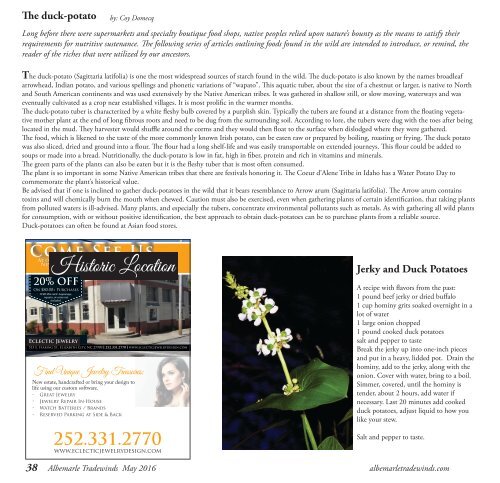Albemarle tradewinds May 2016 web Final
May 2016
May 2016
You also want an ePaper? Increase the reach of your titles
YUMPU automatically turns print PDFs into web optimized ePapers that Google loves.
The duck-potato<br />
by: Coy Domecq<br />
Long before there were supermarkets and specialty boutique food shops, native peoples relied upon nature’s bounty as the means to satisfy their<br />
requirements for nutritive sustenance. The following series of articles outlining foods found in the wild are intended to introduce, or remind, the<br />
reader of the riches that were utilized by our ancestors.<br />
The duck-potato (Sagittaria latifolia) is one the most widespread sources of starch found in the wild. The duck-potato is also known by the names broadleaf<br />
arrowhead, Indian potato, and various spellings and phonetic variations of “wapato”. This aquatic tuber, about the size of a chestnut or larger, is native to North<br />
and South American continents and was used extensively by the Native American tribes. It was gathered in shallow still, or slow moving, waterways and was<br />
eventually cultivated as a crop near established villages. It is most prolific in the warmer months.<br />
The duck-potato tuber is characterized by a white fleshy bulb covered by a purplish skin. Typically the tubers are found at a distance from the floating vegetative<br />
mother plant at the end of long fibrous roots and need to be dug from the surrounding soil. According to lore, the tubers were dug with the toes after being<br />
located in the mud. They harvester would shuffle around the corms and they would then float to the surface when dislodged where they were gathered.<br />
The food, which is likened to the taste of the more commonly known Irish potato, can be eaten raw or prepared by boiling, roasting or frying. The duck potato<br />
was also sliced, dried and ground into a flour. The flour had a long shelf-life and was easily transportable on extended journeys. This flour could be added to<br />
soups or made into a bread. Nutritionally, the duck-potato is low in fat, high in fiber, protein and rich in vitamins and minerals.<br />
The green parts of the plants can also be eaten but it is the fleshy tuber that is most often consumed.<br />
The plant is so important in some Native American tribes that there are festivals honoring it. The Coeur d’Alene Tribe in Idaho has a Water Potato Day to<br />
commemorate the plant’s historical value.<br />
Be advised that if one is inclined to gather duck-potatoes in the wild that it bears resemblance to Arrow arum (Sagittaria latifolia). The Arrow arum contains<br />
toxins and will chemically burn the mouth when chewed. Caution must also be exercised, even when gathering plants of certain identification, that taking plants<br />
from polluted waters is ill-advised. Many plants, and especially the tubers, concentrate environmental pollutants such as metals. As with gathering all wild plants<br />
for consumption, with or without positive identification, the best approach to obtain duck-potatoes can be to purchase plants from a reliable source.<br />
Duck-potatoes can often be found at Asian food stores.<br />
Jerky and Duck Potatoes<br />
A recipe with flavors from the past:<br />
1 pound beef jerky or dried buffalo<br />
1 cup hominy grits soaked overnight in a<br />
lot of water<br />
1 large onion chopped<br />
1 pound cooked duck potatoes<br />
salt and pepper to taste<br />
Break the jerky up into one-inch pieces<br />
and put in a heavy, lidded pot. Drain the<br />
hominy, add to the jerky, along with the<br />
onion. Cover with water, bring to a boil.<br />
Simmer, covered, until the hominy is<br />
tender, about 2 hours, add water if<br />
necessary. Last 20 minutes add cooked<br />
duck potatoes, adjust liquid to how you<br />
like your stew.<br />
Salt and pepper to taste.<br />
38 <strong>Albemarle</strong> Tradewinds <strong>May</strong> <strong>2016</strong> albemarle<strong>tradewinds</strong>.com

















